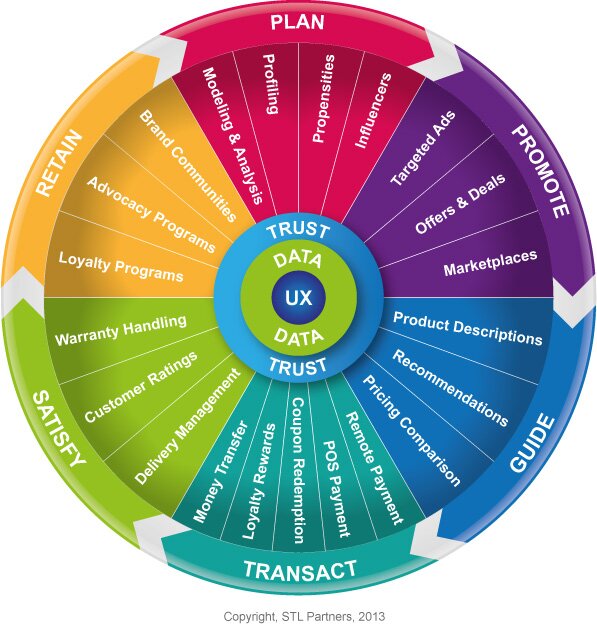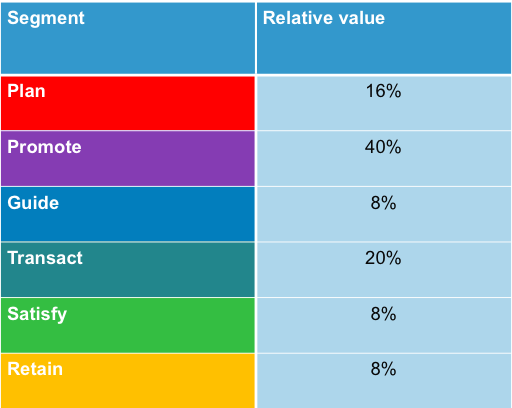Telco 2.0™ Research
The Future Of Telecoms And How To Get There
The Future Of Telecoms And How To Get There
|
Summary: This report will help digital commerce players assess some tough technology and strategy choices in the on-going mobile marketing and commerce battle. E.g. Will bricks and mortar merchants embrace NFC or Bluetooth Low Energy (BLE) or cloud-based solutions? If NFC does take off, will SIM cards or trusted execution environments be used to secure services? Should digital commerce brokers use SMS, in-app notifications or IP-based messaging services to interact with consumers? What are the big players backing, and what will be the key indicators that a specific technology is likely to win? (February 2014, Executive Briefing Service, Dealing with Disruption Stream.) |
|
Below is an extract from this 43 page Telco 2.0 Report that can be downloaded in full in PDF format by members of the Telco 2.0 Executive Briefing service and the Dealing with Disruption Stream here. Non-members can subscribe here, buy a Single User license for this report online here for £795 (+VAT for UK buyers), or for multi-user licenses or other enquiries, please email / call +44 (0) 207 247 5003.
We will also be covering mobile marketing and commerce in depth at our Silicon Valley (Palo Alto, May 20-21) and EMEA (London, June 10-11) Brainstorms.
To share this article easily, please click:
In this briefing, we analyse the bewildering array of technologies being deployed in the on-going mobile marketing and commerce land-grab. With different digital commerce brokers backing different technologies, confusion reigns among merchants and consumers, holding back uptake. Moreover, the technological fragmentation is limiting economies of scale, keeping costs too high.
This paper is designed to help telcos and other digital commerce players make the right technological bets. Will bricks and mortar merchants embrace NFC or Bluetooth Low Energy or cloud-based solutions? If NFC does take off, will SIM cards or trusted execution environments be used to secure services? Should digital commerce brokers use SMS, in-app notifications or IP-based messaging services to interact with consumers?
STL defines Digital Commerce 2.0 as the use of new digital and mobile technologies to bring buyers and sellers together more efficiently and effectively (see Digital Commerce 2.0: New $Bn Disruptive Opportunities for Telcos, Banks and Technology Players). Fast growing adoption of mobile, social and local services is opening up opportunities to provide consumers with highly-relevant advertising and marketing services, underpinned by secure and easy-to-use payment services. By giving people easy access to information, vouchers, loyalty points and electronic payment services, smartphones can be used to make shopping in bricks and mortar stores as interactive as shopping through web sites and mobile apps.
This executive briefing weighs the pros and cons of the different technologies being used to enable mobile commerce and identifies the likely winners and losers.
This section explains the driving forces behind the mobile commerce land-grab and the associated technology battle.
Digital commerce is evolving fast, moving out of the home and the office and onto the street and into the store. The advent of mass-market smartphones with touchscreens, full Internet browsers and an array of feature-rich apps, is turning out to be a game changer that profoundly impacts the way in which people and businesses buy and sell. As they move around, many consumers are now using smartphones to access social, local and mobile (SoLoMo) digital services and make smarter purchase decisions. As they shop, they can easily canvas opinion via Facebook, read product reviews on Amazon or compare prices across multiple stores. In developed markets, this phenomenon is now well established. Two thirds of 400 Americans surveyed in November 2013 reported that they used smartphones in stores to compare prices, look for offers or deals, consult friends and search for product reviews.
At the same time, the combination of Internet and mobile technologies, embodied in the smartphone, is enabling businesses to adopt new forms of digital marketing, retailing and payments that could dramatically improve their efficiency and effectiveness. The smartphones and the data they generate can be used to optimise and enable every part of the entire ‘wheel of commerce’ (see Figure 4).

Source: STL Partners
The extensive data being generated by smartphones can give companies’ real-time information on where their customers are and what they are doing. That data can be used to improve merchants’ marketing, advertising, stock management, fulfilment and customer care. For example, a smartphone’s sensors can detect how fast the device is moving and in what direction, so a merchant could see if a potential customer is driving or walking past their store.
Marketing that makes use of real-time smartphone data should also be more effective than other forms of digital marketing. In theory, at least, targeting marketing at consumers in the right geography at a specific time should be far more effective than simply displaying adverts to anyone who conducts an Internet search using a specific term.
Similarly, local businesses should find sending targeted vouchers, promotions and information, delivered via smartphones, to be much more effective than junk mail at engaging with customers and potential customers. Instead of paying someone to put paper-based vouchers through the letterbox of every house in the entire neighbourhood, an Indian restaurant could, for example, send digital vouchers to the handsets of anyone who has said they are interested in Indian food as they arrive at the local train station between 7pm and 9pm in the evening. As it can be precisely targeted and timed, mobile marketing should achieve a much higher return on investment (ROI) than a traditional analogue approach.
In our recent Strategy Report, STL Partners argued that the disruption in the digital commerce market has opened up two major opportunities for telcos:
These two opportunities are inter-related and could be combined in a single platform. In both cases, the telco is acting as a broker – matching buyers and sellers as efficiently as possible, competing with incumbent digital commerce brokers, such as Google, Amazon, eBay and Apple. The Strategy Report explains in detail how telcos could pursue these opportunities and potentially compete with the giant Internet players that dominate digital commerce today.
For most telcos, the best approach is to start with mobile commerce, where they have the strongest strategic position, and then use the resulting data, customer relationships and trusted brand to expand into personal cloud services, which will require high levels of investment. This is essentially NTT DOCOMO’s strategy.
However, in the mobile commerce market, telcos are having to compete with Internet players, banks, payment networks and other companies in land-grab mode - racing to sign up merchants and consumers for platforms that could enable them to secure a pivotal (and potentially lucrative) position in the fast growing mobile commerce market. Amazon, for example, is pursuing this market through its Amazon Local service, which emails offers from local merchants to consumers in specific geographic areas.
Moreover, a bewildering array of technologies are being used to pursue this land-grab, creating confusion for merchants and consumers, while fuelling fragmentation and limiting economies of scale.
In this paper, we weigh the pros and cons of the different technologies being used in each segment of the wheel of commerce, before identifying the most likely winners and losers. Note, the appendix of the Strategy Report profiles many of the key innovators in this space, such as Placecast, Shopkick and Square.
This section considers the relative importance of the different segments of the wheel of commerce and explains why the key technological battles are taking place in the promote and transact segments.
STL Partners’ recent Strategy Report models in detail the potential revenues telcos could earn from pursuing the real-time commerce and personal cloud opportunities. That is beyond the scope of this technology-focused paper, but suffice to say that the digital commerce market is large and is growing rapidly: Merchants and brands spend hundreds of billions of dollars across the various elements of the wheel of commerce. In the U.S., the direct marketing market alone is worth about $155 billion per annum, according to the Direct Marketing Association. In 2012, $62 billion of that total was spent on digital marketing, while about $93 billion was spent on traditional direct mail.
In the context of the STL Wheel of Commerce (see Figure 3), the promote segment (ads, direct marketing and coupons) is the most valuable of the six segments. Our analysis of middle-income markets for clients suggests that the promote segment accounts for approximately 40% of the value in the wheel of digital commerce today, while the transact segment (payments) accounts for 20% and planning (market research etc.) 16% (see Figure 5). These estimates draw on data released by WPP and American Express.
Note, that payments itself is a low margin business – American Express estimates that merchants in the U.S. spend four to five times as much on marketing activities, such as loyalty programmes and offers, as they do on payments.

Source: STL Partners
To read the note in full, including the following analysis...
...and the following figures...
...Members of the Telco 2.0 Executive Briefing Subscription Service and the Dealing with Disruption Stream can download the full 43 page report in PDF format here. Non-Members, please subscribe here, buy a Single User license for this report online here for £795 (+VAT for UK buyers), or for multi-user licenses or other enquiries, please email / call +44 (0) 207 247 5003.
Technologies and industry terms referenced: NFC, Bluetooth Low Energy (BLE), WiFi, SIM, Mobile, PayPal, Google, Apple, TripAdvisor, moneysavingexpert.com, comparethemarket.com. American Express (AMEX), Placecast, Shopkick, Square, NTT DOCOMO, Amazon, mobile marketing, digital commerce.